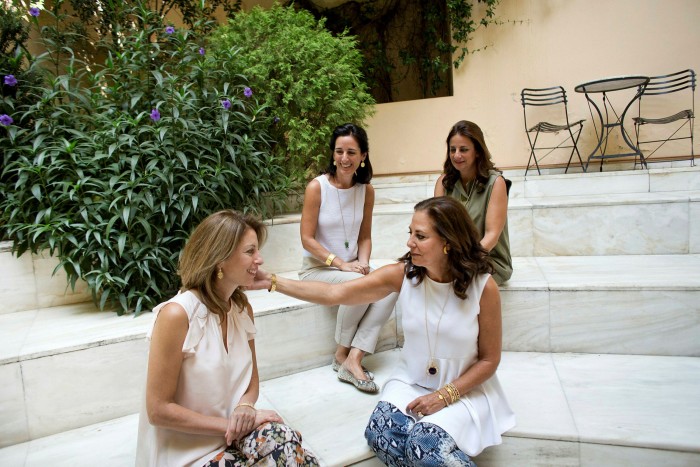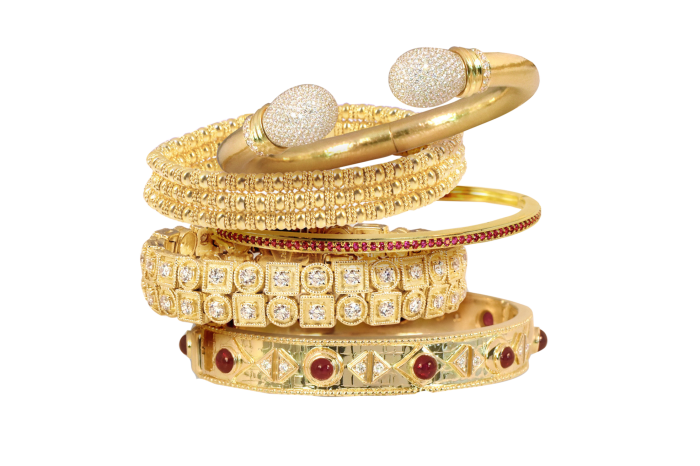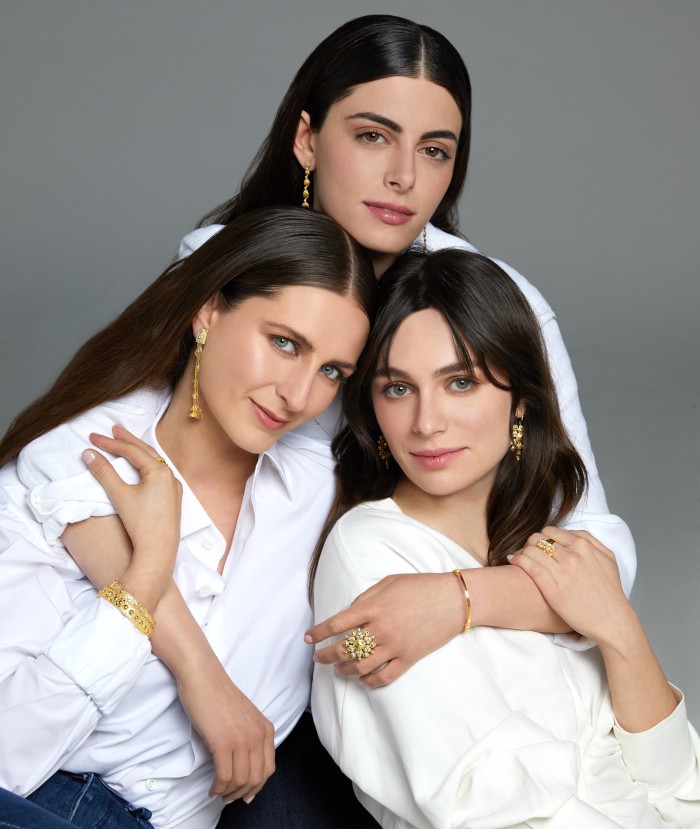Close family ties keep Lalaounis’s jewellery business alive

Roula Khalaf, Editor of the FT, selects her favourite stories in this weekly newsletter.
If there is one company that could lay claim to first putting the art of Greek jewellery on the international map, then it is arguably Lalaounis. Founded in 1969 by Ilias Lalaounis, who died in 2013, the company has been run since 1998 by his four daughters: Demetra, Ioanna, Aikaterini and Maria.
Lalaounis is also one of the few family-owned jewellery companies of this era to have expanded internationally, adapted to the digital age, and survived several financial ups and downs.
So what is behind Lalaounis’s strength and endurance?
“The family element has given a lot of continuity and brand identity, which gives them longevity,” says Victor Lee, a consultant to luxury brands who has worked with the business.
“[Being] a family, all pulling in the same direction, with no competing interests, is a huge strength for them. Their uniqueness is another crucial strength. Like Louis Vuitton, Chanel or Hermès, Lalaounis has remained true to its heritage — it hasn’t wavered.”
Henry Bailey, head of the jewellery department at Christie’s in London, explains the impact of Lalaounis: “In the 1980s, gold jewellery was popular and Lalaounis designs chimed with the fashion of the time, with bolder forms than in previous decades. Lalaounis reignited a generation of craftsmen in Greece and inspired other contemporary jewellers.
“The jewels are highly recognisable and one immediately thinks of Greece, but the collector base for Lalaounis is beyond Greece — it is not just a local brand name but internationally collected.”
Much like the few remaining privately owned, niche international jewellery businesses, Lalaounis faces challenges. It is competing in a $280bn global market dominated by three luxury conglomerates — Richemont, Kering and LVMH — and dealing in high-value merchandise amid fluctuating gold prices.

Lalaounis has had to adapt its sales strategy from relying on its own stores to using a mix of these alongside wholesale and ecommerce — all the while maintaining market share on a limited promotional budget.
Jewellery also brings a layer of complexity in the form of international luxury taxes, import tariffs and hallmarking requirements. Smaller companies must overcome these hurdles without the economies of scale of the big luxury brands that dominate the prime retail space from Mayfair to Ginza.
“The jewellery industry has grown and changed immensely in the past two decades,” says Demetra Lalaounis Auersperg, co-chief executive and director of international operations. “I don’t think any other luxury sector has developed in the same way, and jewellery has been the most explosive of all luxury categories, despite the complexity of the production chain and costs.”
The company, which does not disclose any financial information, employs 70 staff, mainly in Greece. It is often compared to Buccellati, the Florentine family-run house, because of the distinctive intricate gold work in its lacelike jewels. Buccellati was acquired by China’s Gangtai Group in 2017 and, two years later, was sold to Richemont for an undisclosed price.
As for identity and heritage, the Lalaounis sisters — and their children, as they are old enough to join the family business — keep the story alive with a zeal inherited from the founder. The instantly recognisable style is supported by the activities of the Ilias Lalaounis Jewelry Museum in Athens, which opened in 1994 and is dedicated to Greek jewellery making.

In the 1940s, Ilias Lalaounis, a law and economics graduate with a love of history, was entrusted with running Zolotas, his uncle’s three-generation-old jewellery house during the difficult years of the second world war. For two decades, Ilias successfully steered the company to international growth, but his desire to do something different led to a parting of ways.
Beyond producing generic jewellery, he wanted to bring his love of Greek culture to his work and create jewels with a deeper meaning. The results were his striking Hellenic-themed jewels made in 22ct hand-hammered gold that turned out to be a turning point in the history of Greek jewellery.
Challenging his craftsmen to make jewels like their ancestors, he revived techniques such as granulation, filigree and weaving — time-consuming manual skills key to the distinctive house look. Unlike other “revivalist” jewellers such as Castellani, Lalaounis did not merely reproduce museum jewels but took details from many disciplines, including architecture and pottery, as a starting point.
Timing was on the business’s side as postwar optimism revived travel and spending, giving rise to the jet set. The glamour of Jackie O shone the international spotlight on the shimmering beaches of the Greek islands and Lalaounis was on hand to provide precious mementos with a distinctive look.
By the early 1990s, the company had 14 boutiques in Greece, France, Switzerland, Hong Kong, Japan and the US, with thousands of designs that embraced a wider range of global cultural references. Such was his repute that Ilias became the first jeweller to be awarded France’s Légion d’Honneur.
As for the company’s products today, the original large-scale designs are less feasible now that gold prices have increased around fourfold since the 1980s. So Maria Lalaounis, co-chief executive and design director, has subtly shifted to lighter pieces that use less gold but achieve a physically big look in the house’s distinctive style.
The US market is particularly keen on the addition of precious gemstones, such as diamonds. And, by adding diamonds, the jewels can command higher price points than the all-gold or coloured gemstone pieces.
Despite a wider cost-saving trend towards producing in Asia, all Lalaounis jewellery is still made by hand in its Athens workshops, in keeping with the founder’s commitment to maintaining traditional crafts and supporting the local economy.
Consultant Lee considers the craftsmanship element of the brand to be a core advantage. “Those in the top 10 per cent demographic don’t have many choices when it comes to handmade jewellery,” he says. “They know big names with multi-product offerings, but not the niche ones. Once people learn how Lalaounis jewellery is made, it becomes aspirational, as craftsmanship is so rare. People are impressed that they have craftsmen who have been with them for decades.”
However, the combined effect of 9/11, the financial crisis and the Greek debt crisis meant that, by 2017, the only Lalaounis boutiques that remained were in Greece and New York, along with distribution channels in other key locations.
“The decision to close the shops was financially strategic and allowed us to restructure our business,” says Lalaounis Auersperg. “It proved to be very timely, given later issues such as Covid.” The company now has three of its own boutiques in Athens, one in New York and, in the holiday season, a presence on the Greek islands of Mykonos, Santorini and Corfu.
“Greece is our main market because of local customers as well as international clientele, followed by the US and the Middle East,” says Lalaounis Auersperg. “The Asian market, and the Chinese in particular, is a very interesting area for expansion because of their love of gold and fine craftsmanship and, of course, the sheer size of the region. We are also interested in Japan, where the name Lalaounis has a strong historical appeal, but we are taking a slow, cautious approach. The New York office is developing the US wholesale [arm] and a small consignment business.”
At the end of last year, Lalaounis launched its ecommerce platform and is focusing on digital channels to grow brand awareness. All advertising and marketing is done in house to save costs and, following tradition, occasionally uses family members as models.
The Lalaounis sisters are looking to the future. “We are adding to the traditional print advertising model with Instagram and ecommerce to expand and reach a younger audience, while maintaining a physical retail presence and a close connection with our clients, which our father had always done,” says Lalaounis Auersperg.
Comments